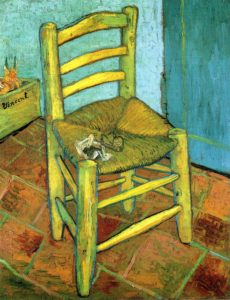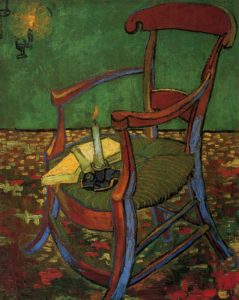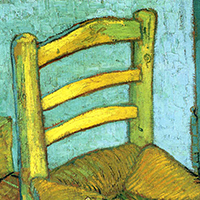Al fondo de la M. D. del M. (Mayor Droguería del Mundo] entre juguetes, tarjetas postales e historietas, había de modo sorprendente una estantería de libros de arte. Tomé el volumen que tenía más a mano. Era sobre Van Gogh y el cuadro en el que el libro se abrió era La silla, ese asombroso retrato de una Ding an Sich, que el pintor loco vio, con una especie de terror de adoración, y trató de trasladar a la tela. Pero fue un empeño para el que hasta el poder del genio fue una insuficiencia vital. La silla que Van Gogh había visto era evidentemente la misma en esencia que yo había visto. Pero incomparablemente más real que la silla de la percepción ordinaria, la silla de su cuadro no pasaba de ser un símbolo desusadamente expresivo del hecho. El hecho había sido Identidad manifestada; esto, en cambio, era únicamente un emblema. Emblemas así son las fuentes del verdadero conocimiento acerca de la Naturaleza de las Cosas y este verdadero conocimiento puede preparar a la inteligencia que lo acepta para intuiciones inmediatas por propia cuenta. Pero esto es todo. Por expresivo que sean, los símbolos no pueden ser las cosas que representan.
Sería interesante a este respecto hacer un estudio de las obras de arte que tuvieron a su disposición los grandes conocedores de Identidad. ¿Qué clase de cuadros contempló Eckhart? ¿Qué esculturas y pinturas representaron un papel en la experiencia religiosa de San Juan de la Cruz, de Alcuino, de Hui-Neng, de William Law? Son preguntas a las queno puedo contestar, pero mucho me sospecho que la mayoría de los grandes conocedores de Identidad dedicaron muy poca atención al arte, negándose algunos a tener nada que ver con él y contentándose otros con lo que un ojo crítico consideraría obras de segunda clase y hasta de décima. (Para una persona cuya inteligencia transfigurada y transfigurante puede ver el Todo en cada esto, el que una pintura, inclusive religiosa, sea de primera o de décima clase tiene que ser asunto que lo deje en la más soberana indiferencia.) Yo supongo que el Arte es únicamente para principiantes o, en otro caso, para quienes van con resolución hasta el fin, para quienes han decidido contentarse con el ersatz de Identidad, con símbolos y no con lo que significan, con la minuta elegantementepresentada en lugar de la comida real.
Aldoux Huxley, Las puertas de la percepción, 1954

Vincent van Gogh created two portraits of chairs in 1888 during the time that Paul Gauguin was visiting him in The Yellow House at Arles. One chair was Van Gogh’s the other Gauguin’s. Empty chairs have frequently been used as the personification of the people who own them. This leads to much discussion surrounding the idea that the companion paintings may have been intended to represent the contrasting temperaments of the two artists.
Gauguin’s chair is portrayed in the evening or night and is red, baroque style with curved backrest and upholstered seat, and has a burning candle and books sitting on it. The chair rests on a colorful carpet with a green wall and blazing lamp in the background. Van Gogh’s chair, on the other hand, is simpler, yellow in color and sits on a brown tile floor with a blue wall and closed blue door in the background along with a box of onions with his signature on it. Resting on the chair are a pipe and tobacco pouch.
Van Gogh’s chair is simple, surrounded by a sober room and in the natural light of day. Gauguin’s chair is more elegant and the surrounding room more luxurious and lit with artificial light. The books sitting on his chair are thought to be modern French novels which might act as signs of his modern flare or perhaps a statement of intellect.

Though offering no hint as to any underlying statements Van Gogh wrote to his brother, Theo, about the chairs on January 17, 1889,
“I should like De Haan to see a study of mine of a lighted candle and two novels (one yellow, the other pink) lying on an empty chair (really Gauguin’s chair), a size 30 canvas, in red and green. I have just been working again today on its pendant, my own empty chair, a white deal chair with a pipe and a tobacco pouch. In these two studies, as in others, I have tried for an effect of light by means of clear colour, probably De Haan would understand exactly what I was trying to get if you read to him what I have written on the subject.”
http://blog.vangoghgallery.com/index.php/en/2012/07/29/van-gogh-and-gauguins-chairs/
